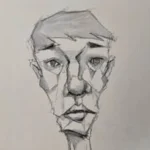Plato’s Chicken jumped to Switzerland and in exhibition in Thompson gallery. It is digital exhibition on screen by Artboxy. I am planning to keep exhibit my recent figure works for a while.
So why Plato’s chicken? According to Wikipedia:
Plato once described Diogenes as “a Socrates gone mad.”[35] According to Diogenes Laërtius, when Plato gave the tongue-in-cheek[36] definition of man as “featherless bipeds”, Diogenes plucked a chicken and brought it into Plato’s Academy, saying, “Here is Plato’s man” (Οὗτός ἐστιν ὁ Πλάτωνος ἄνθρωπος), and so the academy added “with broad flat nails” to the definition
Plato unintentionally defined a human as a “featherless biped,” and Diogenes mocked him with a plucked chicken. When I finished this painting, my daughter said, “It reminds me of the story of Plato’s chicken.” Maybe it’s the pose that resembles a chicken? I’m not sure.
Platonic philosophy plays a key role in my work, as Plato believed the body is merely a tool for the soul, and that the soul and body are in constant struggle—an idea that aligns with the struggle I feel in my own art.
The question I continue to ask is, “What is human?” In this painting, I depict a human flying toward a goal (the circle at the bottom left, perhaps symbolizing the world of IDEAS), yet I still cannot clearly answer that question. So, I wrote down the words in the background I don’t understand. I also wondered, if Plato were alive today, how he might define ‘chicken’ and whether his definition of a chicken would be close to his definition of a human—or not.
Bonus: Adding another fable(maybe from Plato)
Once upon a time, there was a human who lived in a small village and noticed that a chicken behaved differently from others of its kind. This chicken, instead of pecking at the ground to find food, would act strangely and often show more complex behavior. The human, curious, began to follow this chicken, observing its actions and ways.
Over time, it became clear that the chicken was more than just an animal — it was foolish but clever and had an uncanny ability to attract attention in peculiar ways. The human was fascinated by the chicken’s strange behavior, leading to a kind of connection between the two. But as the myth continues, we realize that the chicken’s strange behavior didn’t lead to wisdom, truth, or understanding of higher moral values. Instead, it led the human to questions of what is virtuous and true in the face of this behavior.







